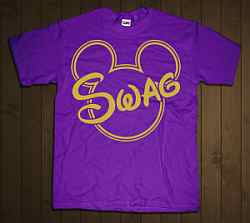FROM: Running with the Mouse Published As Needed
How to Select Your Disney Running Shoes
I remember my parents taking me, as a kid, to our small-town shoe store every August to buy me a new pair of Keds for the school year. But if you plan to run in a Disney race, don't do what my parents did; follow Jennifer Lazzaro's advice, instead.
One question I'm asked often by friends who want to start running, especially in Disney races, is what kind of running shoes I wear. I happily tell them of my love for Nike's, but then quickly add that everyone is different: while Nike may be the best choice for my feet, they may not be the best choice for someone else's feet.
Which then leads to the next question: how to select a good pair of running shoes?
Your choice of running shoes can make the difference between a good or bad experience, running in comfort or pain, and most important, whether you stay healthy or suffer injury.
My main advice is to visit a running specialty store for a  proper fitting. Let the salesperson know that you're new to running and have never been properly fitted before. Don't make the mistake of buying a bargain pair from the store's clearance table or, worse, from the bin at a department store.
proper fitting. Let the salesperson know that you're new to running and have never been properly fitted before. Don't make the mistake of buying a bargain pair from the store's clearance table or, worse, from the bin at a department store.
If you do that, you WILL have a bad experience when you try to run in those shoes, and that may make you give up before you've even run your first mile.
Each person has a different gait and a different foot shape. Even among people of the same general build, body weight is often dispersed differently, which affects the type of shoe best for them.
Before a knowledgeable salesperson recommends a particular brand and style of shoe, he should not only evaluate your gait, foot shape, and weight distribution, but also ask you these questions:
Knowledgeable salespeople should ask you these questions:
- How much running experience, if any, do you have?
- How many miles a week do you run?
- What type of surface do you run on (asphalt streets, concrete sidewalks, dirt trails, etc)?
- Do you have any nagging injuries or occasional pain when walking or running?
- Do you have any short-term goals for your running program? For example, are you training for an upcoming race? Or do you simply want to get around the block three or four times a week?

The people at the store where I buy my running shoes have each new customer walk or run on a treadmill so they can analyze the customer's gait.
Don't buy shoes from anyone who doesn't first take the time to learn your gait, since it's one of the most important factors in determining the right pair of shoes for your feet.
Although gait is important, foot shape is crucial. The salespeople will determine your foot shape during the fitting. You may have high arches, flat feet, or neutral (normal) feet. You may over-pronate or under-pronate (in other words, your foot may roll in or roll out when you take a step).
If this all sounds like a different language, don't worry. The salespeople should explain everything. And keep in mind that there's no 'right' or 'wrong' gait or foot shape. The important thing is to know what they are so that you can be fitted with the best shoes.
Shoes fall into one of three categories: neutral, stability, or motion control.
Wearing a shoe with too little stability or too much stability can cause numerous problems. It is important to select a shoe appropriate for your foot biomechanics, and not one based merely on color or style.
Another bit of advice is to shop for your running shoes in the afternoon. Why? Because your feet tend to swell slightly throughout the day, and Rule No. 1 is to avoid buying shoes that are too small! Don't be worried if the running store suggests you buy shoes that are a full size bigger than what you normally wear. My feet swell so much that I actually wear running shoes 1.5 sizes bigger than my every day shoes.
A good running specialty shop will not only let you take their shoes for a 5-minute 'test run' outside or on the treadmill - they will encourage you to do so! If the store won't let you test-run the shoes, put your old shoes back on and leave.
Before you buy new shoes, ask about the store's return policy. Any reputable running store has at least a 30-60 day money-back guarantee. If you wear the sneakers and realize they aren't right for you, you should be able to bring them back and exchange them, no questions asked.
After you have the correct sneakers for your feet, get out there and hit the pavement!
More: RUNNING WITH THE MOUSE
Stuff Not to Skip
- Disney's Official Site: Run Disney
http://espnwwos.disney.go.com/sports/rundisney - Jennifer's Blog: Eat, Sleep, Run Disney
http://www.eatsleeprundisney.com - Jennifer on Twitter: DisRunner
http://www.twitter.com/DisRunner - Jennifer on Facebook: Eat, Sleep, Run Disney Fan Page
http://www.facebook.com/EatSleepRunDisney







